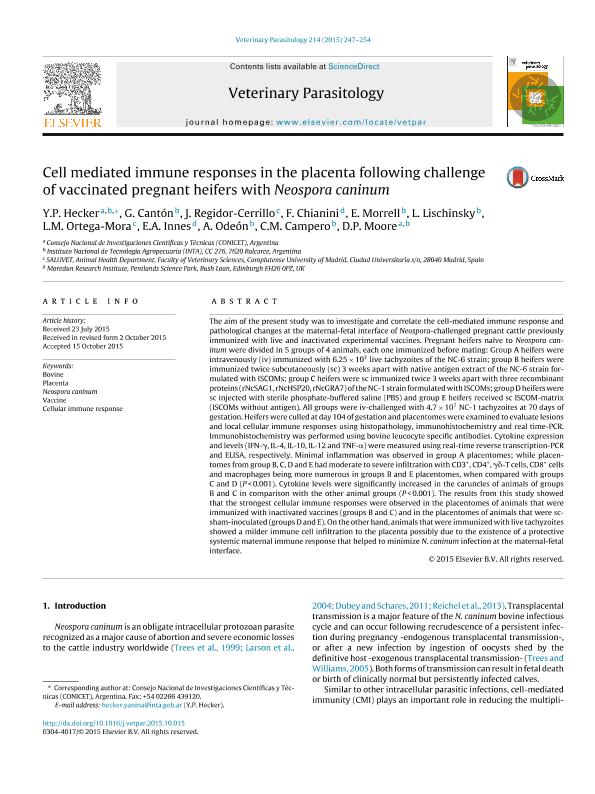Mostrar el registro sencillo del ítem
dc.contributor.author
Hecker, Yanina Paola

dc.contributor.author
Canton, German

dc.contributor.author
Regidor Cerrillo, J.
dc.contributor.author
Chianini, F.
dc.contributor.author
Morrell, Eleonora Lidia

dc.contributor.author
Lischinsky, L.
dc.contributor.author
Ortega Mora, L. M.
dc.contributor.author
Innes, E. A.
dc.contributor.author
Odeón, Anselmo Carlos

dc.contributor.author
Campero, Carlos Manuel

dc.contributor.author
Moore, Dadin Prando

dc.date.available
2018-06-29T19:23:56Z
dc.date.issued
2015-12
dc.identifier.citation
Hecker, Yanina Paola; Canton, German; Regidor Cerrillo, J.; Chianini, F.; Morrell, Eleonora Lidia; et al.; Cell mediated immune responses in the placenta following challenge of vaccinated pregnant heifers with Neospora caninum; Elsevier Science; Veterinary Parasitology; 214; 3-4; 12-2015; 247-254
dc.identifier.issn
0304-4017
dc.identifier.uri
http://hdl.handle.net/11336/50782
dc.description.abstract
The aim of the present study was to investigate and correlate the cell-mediated immune response and pathological changes at the maternal-fetal interface of Neospora-challenged pregnant cattle previously immunized with live and inactivated experimental vaccines. Pregnant heifers naïve to Neospora caninum were divided in 5 groups of 4 animals, each one immunized before mating: Group A heifers were intravenously (iv) immunized with 6.25 × 107 live tachyzoites of the NC-6 strain; group B heifers were immunized twice subcutaneously (sc) 3 weeks apart with native antigen extract of the NC-6 strain formulated with ISCOMs; group C heifers were sc immunized twice 3 weeks apart with three recombinant proteins (rNcSAG1, rNcHSP20, rNcGRA7) of the NC-1 strain formulated with ISCOMs; group D heifers were sc injected with sterile phosphate-buffered saline (PBS) and group E heifers received sc ISCOM-matrix (ISCOMs without antigen). All groups were iv-challenged with 4.7 × 107 NC-1 tachyzoites at 70 days of gestation. Heifers were culled at day 104 of gestation and placentomes were examined to evaluate lesions and local cellular immune responses using histopathology, immunohistochemistry and real time-PCR. Immunohistochemistry was performed using bovine leucocyte specific antibodies. Cytokine expression and levels (IFN-γ, IL-4, IL-10, IL-12 and TNF-α) were measured using real-time reverse transcription-PCR and ELISA, respectively. Minimal inflammation was observed in group A placentomes; while placentomes from group B, C, D and E had moderate to severe infiltration with CD3+, CD4+, γδ-T cells, CD8+ cells and macrophages being more numerous in groups B and E placentomes, when compared with groups C and D (P < 0.001). Cytokine levels were significantly increased in the caruncles of animals of groups B and C in comparison with the other animal groups (P < 0.001). The results from this study showed that the strongest cellular immune responses were observed in the placentomes of animals that were immunized with inactivated vaccines (groups B and C) and in the placentomes of animals that were sc-sham-inoculated (groups D and E). On the other hand, animals that were immunized with live tachyzoites showed a milder immune cell infiltration to the placenta possibly due to the existence of a protective systemic maternal immune response that helped to minimize N. caninum infection at the maternal-fetal interface.
dc.format
application/pdf
dc.language.iso
eng
dc.publisher
Elsevier Science

dc.rights
info:eu-repo/semantics/openAccess
dc.rights.uri
https://creativecommons.org/licenses/by-nc-nd/2.5/ar/
dc.subject
Bovine
dc.subject
Cellular Immune Response
dc.subject
Neospora Caninum
dc.subject
Placenta
dc.subject
Vaccine
dc.subject.classification
Otras Ciencias Veterinarias

dc.subject.classification
Ciencias Veterinarias

dc.subject.classification
CIENCIAS AGRÍCOLAS

dc.title
Cell mediated immune responses in the placenta following challenge of vaccinated pregnant heifers with Neospora caninum
dc.type
info:eu-repo/semantics/article
dc.type
info:ar-repo/semantics/artículo
dc.type
info:eu-repo/semantics/publishedVersion
dc.date.updated
2018-06-29T13:11:54Z
dc.journal.volume
214
dc.journal.number
3-4
dc.journal.pagination
247-254
dc.journal.pais
Países Bajos

dc.journal.ciudad
Amsterdam
dc.description.fil
Fil: Hecker, Yanina Paola. Consejo Nacional de Investigaciones Científicas y Técnicas; Argentina. Instituto Nacional de Tecnología Agropecuaria. Centro Regional Buenos Aires Sur. Estación Experimental Agropecuaria Balcarce; Argentina
dc.description.fil
Fil: Canton, German. Instituto Nacional de Tecnología Agropecuaria. Centro Regional Buenos Aires Sur. Estación Experimental Agropecuaria Balcarce; Argentina
dc.description.fil
Fil: Regidor Cerrillo, J.. Universidad Complutense de Madrid; España
dc.description.fil
Fil: Chianini, F.. Pentlands Science Park; Reino Unido
dc.description.fil
Fil: Morrell, Eleonora Lidia. Consejo Nacional de Investigaciones Científicas y Técnicas; Argentina. Instituto Nacional de Tecnología Agropecuaria. Centro Regional Buenos Aires Sur. Estación Experimental Agropecuaria Balcarce; Argentina
dc.description.fil
Fil: Lischinsky, L.. Instituto Nacional de Tecnología Agropecuaria. Centro Regional Buenos Aires Sur. Estación Experimental Agropecuaria Balcarce; Argentina
dc.description.fil
Fil: Ortega Mora, L. M.. Universidad Complutense de Madrid; España
dc.description.fil
Fil: Innes, E. A.. Pentlands Science Park; Reino Unido
dc.description.fil
Fil: Odeón, Anselmo Carlos. Instituto Nacional de Tecnología Agropecuaria. Centro Regional Buenos Aires Sur. Estación Experimental Agropecuaria Balcarce; Argentina
dc.description.fil
Fil: Campero, Carlos Manuel. Instituto Nacional de Tecnología Agropecuaria. Centro Regional Buenos Aires Sur. Estación Experimental Agropecuaria Balcarce; Argentina
dc.description.fil
Fil: Moore, Dadin Prando. Consejo Nacional de Investigaciones Científicas y Técnicas; Argentina. Instituto Nacional de Tecnología Agropecuaria. Centro Regional Buenos Aires Sur. Estación Experimental Agropecuaria Balcarce; Argentina
dc.journal.title
Veterinary Parasitology

dc.relation.alternativeid
info:eu-repo/semantics/altIdentifier/doi/https://dx.doi.org/10.1016/j.vetpar.2015.10.015
dc.relation.alternativeid
info:eu-repo/semantics/altIdentifier/url/https://www.sciencedirect.com/science/article/pii/S0304401715300534
Archivos asociados
